Sicilian people: mule soldiers, proof of virginity and more.
The elderly Sicilians tell us about the habits of the past. In this episode Vendors of broom, mule soldiers, "nonno sa benerica",…
In this episode: urrrrgggggg, Giu ti amo, Weltlandschaft, cannoli weighing 300 kilos, mamma li Turchi !, and many fountains
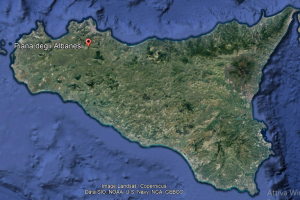
2500 years of couplings between different people.
You are in Sicily.
The first Sicilians lived in caves, ate shellfish and berries, danced to make it rain and say uuurrrrggggurguuuuuurrg.
Then came the Phoenicians and the Greeks and then the urg learned.
And then again Romans, Arabs, Normans, Swabians and so on
Sicilian is a mixture of Greek, Arabic and Latin.
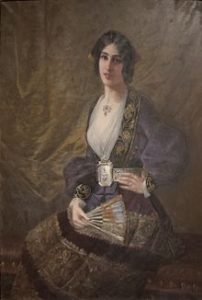
It is blond, dark, tall, short; as indolent as it is hospitable; as sleepy as it is energetic.
This is what also happened, in this land that had more invaders, queens and princes than fish in the sea, that towards the end of the 1400s a colony of Albanians settled here and there in Sicily.
They escaped the Turkish invasion of their country.
Today they have become Sicilian-Albanian but they still speak ancient Albanian and do other strange things.
And we went to visit them in their most important den: Piana degli Albanesi, western Sicily, near the capital Palermo.
Piana degli Albanesi is embraced by a lake and surrounded by rugged mountains, which immortalizes this place as if it were one of those wonderful Weltlandschaft, or World landscapes of sixteenth-century painting.
It seems that Peter Bruegel painted his escape into Egypt here in 1563.
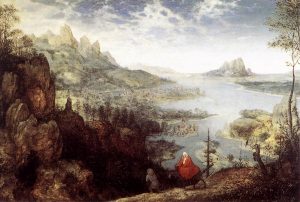
Or that Rubens imagined Piana degli Albanesi in this strongly Sicilian landscape.
And then, I close my eyes, and enter the arbereshe canvas by Giorgio Skandeberg, the hero of the Albanians of Sicily.
Here I am in Piazza Grande.
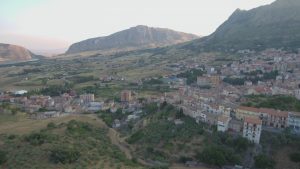
The birds sing, probably in Albanian.
Here is one of the many fountains that characterize this town: this is the one with the three mouths dating back to 1600.
Let’s take a walk.
Sniff sniff something smells good!
It comes out from that door.
Let’s go check.
The lady between the Albanian and the Sicilian explains to us that she makes this bread in the wood oven.
Incredible but true: in this Sicilian town we need a translator with us because otherwise with some elderly people we would risk not understanding anything.
She explains how she prepares it.
And then she gives me one!
I understood this!
Nar: Ma’m, do you feel more Sicilian or Albanian?
She: Arbereshe! I’m from Piana!
The lady shows us the bilingual written label of the oven: Italian and Albanian.
Here comes a customer.
And the lady greets us in Albanian.
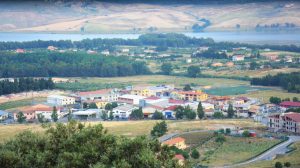
Here is another fountain: on the left for the animals and on the right for the Sicilian-Albanians.
Our canvas takes shape more and more.
This must have been the landscape before the birth of Piana.
And that is the spirit of Giorgio Skandeberg as he sets out to found his new town.
Let’s take this staircase.
On the wall is written, in Italian, Giu I love you.
Giu can be either for a man Giuseppe or for a woman Giuseppina.
So, or maybe a picciotto from Palermo came here and met a beautiful Albanian picciotta and wrote to her about his love in Italian, or vice versa.
We do not put this in the canvas, too modern!
A Sicilian-Albanian butterfly passes in front of my eyes.
Nar: Are you Sicilian-Albanian?
She: Yes. We are very concern to preserve the traditions of our ancestors.
We are in the historic center.
We enter the stone alleys and low Sicilian houses.
Another fountain inside this Arabian tunnel.
Let’s go back to the piazza.
A vegetable and egg vendor
Nar: How do you say eggs in Albanian?
He: XXXX
Another fountain with children.
Nar: Listen, little boy, how do you say fountain in Albanian?
He: XXXX
Music in the piazza.
Gypsy dances in this small enclave with an oriental flavor that is Piana degli Albanesi.
We slip back into the alleys.
The beauty of Piana lies precisely in these walks in its historic center, a real time machine.
And I am a beautiful Sicilian-Albanian from the 1400s who wanders among the houses of the town by candlelight.
So many brooms out there!
Nar: Good morning ma’am. Will you let me into a Sicilian-Albanian house?
She: Please come in. I was cleaning.
Well, it couldn’t be otherwise: hospitality is a common feature of the Sicilians and the Albanians.
Nar: Good morning, are you also cleaning today? Do you also speak Albanian?
She: I’m Albanian.
Nar: How do you say cleaning the house.
She: XXXX
Nar: Good work then.
Hey, more musicians!
Uhmmmm… I think these two are following me.
Let’s play some music then.
A Sicilian-Albanian tarantella!
And an Albanian cantata.
Nar: Hi how does it feel to live in Piana degli Albanesi.
He: Xxxx
Nar: Listen, can you tell me if you prefer what you told me in Italian or Sicilian?
He: Sorry, of course. It is nice to stay here , we are under the mountain and it feels good. I dedicate myself to passing on our culture. I play an Arbereshe religious piece.
Well: here the cantata is not lacking for the Sicilian-Albanians!
Here is our dear fountain.
The lady drinks heartily.
What a beautiful Sicilian rock, isn’t it?
And the low and close houses that tell of a united and complicit community.
Here, if you forget to buy salt, the neighbor will pass it through the window.
Uhmmm what a beautiful palace.
Let’s go in.
It is the ethno-anthropological museum.
There are tools of the farmers and models of the typical farms of the area where the Sicilian-Albanians moved for several months in summer.
They are real fiefdoms with small churches inside.
There is an ancient room with a portable bathroom and children’s clothes.
This is the reconstruction of an underground environment of the Grotta del Garrone with evergreen vegetation.
The cave is located in the beautiful mountains of Piana degli Albanesi, a paradise for hikers.
Serre della Pizzuta are an oasis of green in a red circle.
In this room there are the beautiful and precious Albanian costumes.
The customs of Piana degli Albanesi impressed the 18th century travelers who were in these parts.
I would look great in that!
She: This is our wedding dress, typical of Piana degli Albanesi.
Here I am inside the canvas again: there are also the musicians, the lake, and the first houses of Piana degli Albanesi.
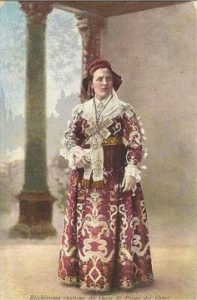
Ok let’s continue the walk.
What a nice smell!
Nar: Hello what are you preparing?
He: The cannoli shells
Mamma Mia! The famous Sicilian cannoli from Piana degli Albanesi: the best in the world!
And also the biggest in the world.
He: Once we made one of 300 kilos, 8 years ago, for the cannoli festival.
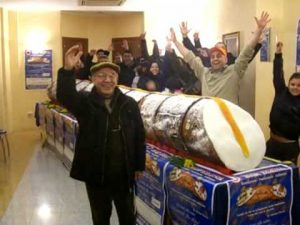
SMASHING LOCAL
Rosario Petta, mayor of Piana degli Albanesi
Just 20 kilometers from Palermo you will find yourself immersed in an island within the island. Our town was founded 530 years ago by Albanian exiles. We jealously preserve customs and traditions. It is a blast from the past here in Piana. You will find genuine food: bread, oil and above all our famous cannoli. We are waiting for you here in Piana, a center framed in a lake.
What a beautiful bridge!
It is called the Te Tozia viaduct and divides the old city from the new one.
He: Rosanna, this is Pino Barone, one of the most famous iconographers around. All hand drawn, all on gold leaf. He is a great teacher.
They are real masterpieces of Byzantine art, handed down for centuries and famous all over the world.
He: This represents the nativity.
The master explains how an icon is prepared.
The preparation of the tablet is an art within an art.
It is a magical canvas!
There are rabbit glues, minerals, egg yolks, vinegar and pure gold.
He: Gold recalls the divine color. It is not a symbol of wealth, but of faith.
He: Xxxxx
Nar: What does that mean?
He: Welcome
We are again in Corso Giorgio Kastriota with Giorgio Kastriota in the center of the square.
Giorgio Kastriota is to the Albanians as Paddy to the Irish or Nelson Mandela to the South Africans.
He is their hero, the man who has always fought against the Turkish enemy and the identity of the Albanian people.
We enter the cathedral from the back.
It is a masterpiece of Greek-Byzantine art with an amazing wooden iconostasis that leaves you breathless.
He: We have a married priest. He must get married before reciting the first mass, otherwise he can no more.

From “Sicilia esterno giorno”, 2012, (Italian Public Network): a program by Giovanni Vallone
edited by Fabiana Carobolante – With Daria Corrias and Lorenzo Pavolini
Sotir Ferrara, Eparch of Piana degli Albanesi “My father was from Palermo and he married my mother who was from Piana. They lived here and my father understood everything perfectly but he badly spoke our language . Also because when he spoke they made fun of him. I learned Italian in kindergarten, I didn’t know anything before. People are curious that we can get married, but that’s the way it is. There is somenthing that I want to say. In one of our prayers to Mary we take it out on the Turkish invader, evil and black. And I am sorry for this because it is not possible to say bad things against others! Something must be done. Certain things cannot be said. And then it’s been a long time, come on!”
Din don… some bells ring in my head!
What can it be?
Ah, here : jewels for me!
He: We produce 18th century Sicilian gold and Albanian costumes.
A beautiful dress and a beautiful Albanian jewel.
They would look good on me!
How wonderful friends from all over the world!
Gold makes me hungry.
And then let’s go with the cannoli!
He: In our laboratory we make cannoli that go around the world. This is sheep’s milk ricotta with chocolate chips, candied fruit and icing sugar, and is ready to be eaten by you.
Are you challenging me?
Look that I am a woman but I am still Sicilian.
Two cannoli for me!
It was a wonderful Sicilian-Albanian day.
I do not want to leave this sixteenth-century canvas.
I stay here dreaming on the shores of the lake.
The boatman is coming to get me!
Hey, but it’s the caronte!
Anyway, that’s ok.
I remain inside the canvas.
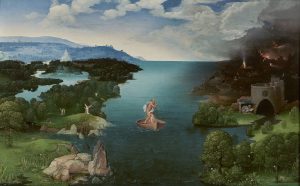
——————————————————————————

Author: Rosanna Paternostro (Cultural Department of Splendid Sicily)
Join our Cultural Department: become a (Splendid) member of Sicily
You have a unique opportunity to support la bella Sicilia.
Contribute to the building of the greatest Cultural Museum of Sicily: you will be ETERNALLY thanked in our video productions and in the related pages.